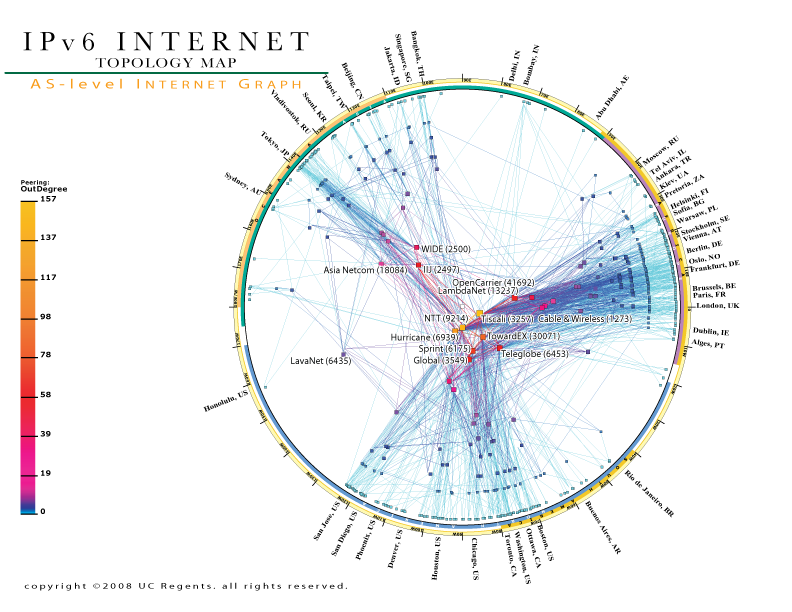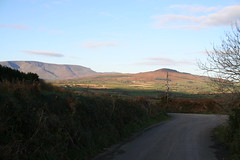21 February 2008
CAIDA IPv6 Topology Maps

I was interested to see that CAIDA had released an updated IPv6 topology map based on statistics gathered in January 2008. The graphs are a visualisation of ASs (Autonomous Systems) in the Internet based on the number of routes between them. ASs are usually controlled by a single owner, and thus this diagram tries to capture logical complexity of the network of networks that is the Internet.
These graphs create an interesting picture of the complexity of the Internet. For comparison have a look at the IPv4 topology map (multiple versions). If you look at these you'll see that the current IPv6 topology is as complex as the IPv4 Internet in 2000, at the height of the dot com boom. Of course the current IPv4 topology is more complex (latest shown currently is 2007).
Ever since I discovered these graphs I have thought that they were a great way to visualise the complexity of the Internet (IPv4 and IPv6).
6 February 2008
Discussion of NAT (and IPv4 address deplation)
Nice to see that we are starting to think of the good things that NAt gave us, as well as planning the move to IPv6 where it will no longer be required. I think this post has it right, NAT served a purpose, now move on.
As IPv6 Deploys, Will We Look Back on NAT as the Ugly Step Sister or Unsung Hero?
Internet prediced to reach zettabyte (annual US traffic)

From YouTube, IPTV, and high-definition images, to “cloud computing” and ubiquitous mobile cameras—to 3D games, virtual worlds, and photorealistic telepresence—the new wave is swelling into an exaflood of Internet and IP traffic. An exabyte is 10 to the 18th. We estimate that by 2015, U.S. IP traffic could reach an annual total of one zettabyte (1021 bytes), or one million million billion bytes.
Internet Undersea Cables (Guardian, UK)

SeaCableHi.jpg (JPEG Image, 1703x1037 pixels) - Scaled (92%)
Thanks to James Mernin.
5 February 2008
IPv6 Address Added for Root Servers in the Root Zone
ICANN | IPv6 Address Added for Root Servers in the Root Zone
MARINA DEL REY, Calif.: The Internet Corporation for Assigned Names and Numbers today took another step along the path of deployment for the next-generation IPv6 Internet addressing system.IPv6 addresses were added for six of the world’s 13 root server networks (A, F, H, J, K, M) to the appropriate files and databases. This move allows for the possibility of fuller IPv6 usage of the Domain Name System (DNS). Prior to today, those using IPv6 had needed to retain the older IPv4 addressing system in order to be able to use domain names.
"The ISP community welcomes this development as part of the continuing evolution of the public Internet,” said Tony Holmes, chair of ICANN’s Internet Service and Connectivity Provider Constituency. “IPv6 will be an essential part our future and support in the root servers is essential to the growth, stability, and reliability of the public Internet.”
Name server software relies on the root servers as a key part in translating domains like “icann.org” into the routing identifiers used by computers to connect to one another. In 2007 the ICANN Security and Stability Advisory Committee concluded that ICANN should move forward with the enhancement of the DNS root service by adding IPv6 addresses for the root servers.
As more and more devices connect to the Internet they require unique Internet Protocol (IP) addresses. The remaining free pool of unassigned IPv4 addresses is being depleted by the growth of the Internet. IPv6 is the addressing protocol that increases the unique IP addresses from the 4 billion available in IPv4, to more than 340 trillion trillion trillion.
“Today’s addition of IPv6 addresses for the root servers enhances the end-to-end connectivity for IPv6 networks, and furthers the growth of the global interoperable Internet,” added David Conrad, ICANN’s Vice President of Research and IANA Strategy. “This is a major step forward for IPv6-only connectivity and the global migration to IPv6.”
Further technical information on the move is available at http://www.iana.org/reports/root-aaaa-announcement.html
Local Byways
A shot of the mountains in County Waterford.The closer hill is Croughan Hill (390m), with the Comeragh Mountains in the background. The shot was taken on the back road from Newtown towards the 5 Cross Roads (aka Guilcagh Cross Roads). Yahoo Maps


